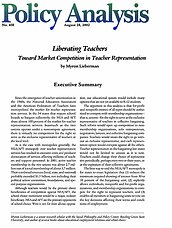As is the case with monopolies generally, the NEA/AFT monopoly over teacher representation services has resulted in excessive costs and producer domination of services affecting millions of teachers and support personnel. In 2001, active teacher membership in the two unions was about 2.7 million out of a total membership of about 3.7 million. Their combined revenues (local, state, and national) probably exceeded $1.5 billion, not including their political action committees, foundations, and special purpose organizations.
Although teachers would be the primary direct beneficiaries of competition against NEA/AFT, the school choice movement would be a major, indirect beneficiary. NEA and AFT are the primary opponents of school choice. Were it not for their all-out opposition, our educational system would include many options that are not yet available to K‑12 students.
The argument in this analysis is that for-profit and nonprofit entities of all types should be authorized to compete with membership organizations–that is, unions–for the right to serve as the exclusive representative of teachers in collective bargaining. Such reform would open up competition to non-membership organizations, solo entrepreneurs, negotiators, lawyers, and collective bargaining companies. Teachers would retain the right to go without an exclusive representative, and each representation option would compete against all the others. Teacher representation in the bargaining-law states would not be limited to unions as it is now. Teachers could change their choice of representative periodically, perhaps every two or three years, or at the expiration of their collective agreements.
The best way to end the NEA/AFT monopoly is for states to enact legislation that (1) reduces the minimum required showing of interest from 30 to 10 percent of the bargaining unit, (2) explicitly allows individuals, nonprofit and for-profit organizations, and membership organizations to compete for the right to represent teachers, and (3) enables all members in bargaining units to vote on the key decisions affecting their terms and conditions of employment.

